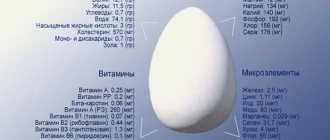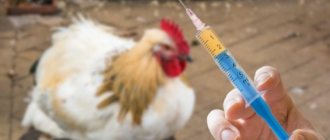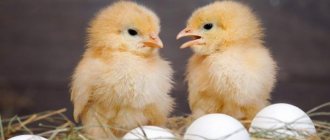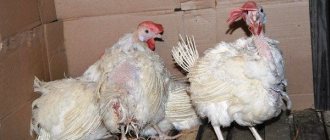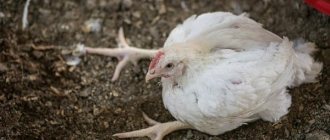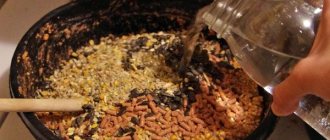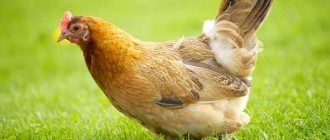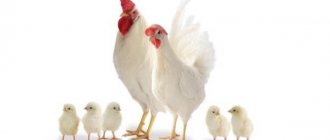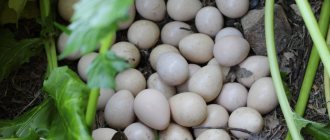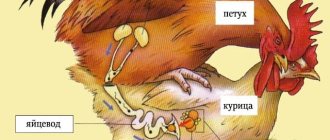Poor nutrition
One of the reasons why chickens lay eggs without shells is poor nutrition. In homesteads, chickens' diet consists of grain and leftover human food. Thus, the birds do not receive enough essential nutrients.
Feeding domestic chickens with scraps and leftover food is suitable for winter frosts at the last meal. This diet is poor in calcium, which is responsible for shell formation. Feeding exclusively with compound feed also does not provide the birds with all the necessary nutrients.
In the case of an incorrect diet, birds initially compensate for the lack of microelements through internal reserves, which is reflected in the fragility of the skeletal system. To detect the problem in a timely manner, poultry farmers should feel the birds once every 14 days. If soft bones are present, measures must be taken: change the diet, introduce calcium supplements, provide birds with access to small stones or crushed shells. Otherwise, prolonged malnutrition can lead to the death of the bird.
Symptoms and course
Some representatives of poultry may experience a temporary loss of the ability to move, softening of the tissues of the beak, claws, keel, and disturbances in gait.
This disease primarily affects young females over the age of fourteen days. They can lay an egg in a very thin shell or without a shell at all , in a thin pouch.
The disease can also manifest itself after several eggs have been laid, when calcium reserves in the bird’s body are depleted. Over time, the disease can lead to stomach catarrh. The sternum becomes deformed, becomes soft, the ribs turn inward.
Hormonal disorders
The soft egg problem occurs due to a hormonal imbalance in the bird. The correct egg laying process consists of the following steps. The first stage is the development of the yolk in the brood hen's ovary. The second stage is the movement of the formed yolk into the oviduct. This stage lasts 24 hours. The third stage is the fertilization of the egg, the formation of the protein and shell. After the chicken has laid an egg, after 30-40 minutes the process starts again and a new egg is formed in the chicken’s ovary.
At any stage of the formation of a chicken egg, failures are possible. For example, the formation of one egg with two yolks, i.e. the failure occurred at the first stage, when the second yolk was formed, but the white had not yet formed. When a bird is under stress for a long period, the egg maturation cycle is disrupted, which leads to the appearance of eggs without shells.
Diet features
The diet of chickens depends on the time of year. The main ingredients of the feed, their rate (g/individual) depending on the time of year are presented in Table 1.
Table 1 – Consumption rates (g/individual) for each type of food depending on the time of year
| Type of food | Season | |||
| December–February | March–May | June August | September–November | |
| fresh vegetation | 0 | 20 | 30 | 20 |
| ground herbal meal | 5 | 3 | 0 | 3 |
| fine gravel | 1 | 1 | 1 | 1 |
| yeast | 3 | 4 | 3 | 3 |
| cake | 12 | 13 | 12 | 12 |
| Ground grains | 50 | 55 | 60 | 55 |
| Cereals | 50 | 45 | 40 | 45 |
| Bone meal | 1 | 1.5 | 1.5 | 1 |
| Meat and bone meal | 5 | 7 | 5 | 5 |
| Vegetables (carrots) | 40 | 20 | 0 | 20 |
| Return | 20 | 30 | 30 | 20 |
| Salt | 0.7 | 0.7 | 0.7 | 0.5 |
| Wheat bran | 10 | 10 | 10 | 10 |
| Chalk, shell rock | 4 | 5 | 4 | 4 |
The diet of laying hens can be of three types.
Wet mash
The wet mash is prepared directly at the poultry farm from three components: boiled and crushed potato tubers, chopped vegetables, wheat bran and various types of cereals. Sometimes meal is added to the mash. Fresh herbs are thoroughly crushed for better absorption.
To moisten the mixture, use whey or settled water. Prepare the mash in such quantity that the birds eat it all at once. Leftover food turns sour, which can cause poisoning. An imbalance in a chicken's digestive tract can negatively impact shell quality.
Dry food
Dry food refers to factory-made compound feed. For laying hens, feed is produced in smaller sizes so that the birds quickly gorge themselves on a small amount of feed. Overfeeding leads to decreased egg production of laying hens and other problems with eggs. The average dose of dry food per day per bird should be no more than 130 g.
Mixed feed
This type of bird diet is a mixture of 1 part feed and 1/3 part grain. In winter, the proportion of grains in mixed feed for laying hens is increased and protein is added to ensure a strong shell.
Supplements
One of the most important food additives responsible for the strength and quality of the shell is calcium. At home, the same eggshells are used as such an additive. Before adding the shells to food, they are first dried and crushed. However, oversaturation of the body with calcium also adversely affects the egg production of laying hens.
Meat and bone meal and soybean meal contain a wide range of macro- and microelements important for chickens. If it is impossible to purchase a certain ingredient for a complete diet for birds, you can replace it with another using Table 2.
Table 2 - Interchangeability of chicken feed
| Name of main feed | Name of replaced feed and consumption rate (g) | ||||||||||||
| corn | oats | oats without films | wheat | barley | barley without films | millet | peas | wheat bran | sunflower cake | potato tubers | meat and bone meal | fish meal | |
| corn | 1 | 1.28 | 1.12 | 1.12 | 1.23 | 1.12 | 1.18 | 1.45 | 1.8 | 1.15 | 4.92 | – | – |
| oats | 0.78 | 1 | 0.87 | 0.87 | 0.96 | 0.87 | 0.92 | 1.13 | 1.4 | 0.89 | 3.83 | – | – |
| oats without films | 0.89 | 1.15 | 1 | 1 | 1.1 | 1 | 1.05 | 1.29 | 1.61 | 1.02 | 4.4 | – | – |
| wheat | 0.89 | 1.15 | 1 | 1 | 1.1 | 1 | 1.05 | 1.29 | 1.61 | 1.02 | 4.4 | – | – |
| barley | 0.81 | 1.04 | 0.9 | 0.9 | 1 | 0.9 | 0.95 | 1.17 | 1.46 | 0.93 | 3.98 | – | – |
| barley without films | 0.92 | 1.18 | 1.03 | 1.03 | 1.14 | 1 | 1.09 | 1.34 | 1.66 | 1.06 | 4.55 | – | – |
| millet | 0.85 | 1.09 | 0.95 | 1.05 | 0.95 | 1 | 1.23 | 1.53 | 0.97 | 4.18 | – | – | – |
| peas | 0.69 | 0.89 | 0.77 | 0.85 | 0.77 | 1.03 | 1 | 1.25 | 0.79 | 3.4 | – | – | – |
| wheat bran | 0.55 | 0.71 | 0.62 | 0.62 | 0.68 | 0.62 | 0.65 | 0.8 | 1 | 0.63 | 2.73 | – | – |
| sunflower cake | 0.87 | 1.12 | 0.97 | 1.08 | 0.97 | 1.03 | 1.26 | 1.57 | 1 | 4.3 | – | – | – |
| potato tubers | 0.2 | 0.26 | 0.22 | 0.22 | 0.25 | 0.22 | 0.24 | 0.3 | 0.36 | 0.23 | 1 | – | – |
| meat and bone meal | – | – | – | – | – | – | – | – | – | – | – | 1 | 0.76 |
| fish meal | – | – | – | – | – | – | – | – | – | – | – | 1.35 | 1 |
The problem of eggs without shells most often occurs in cold weather. The appearance of eggs in the membrane in winter is due to the lack of greenery. To replace them, be sure to give the chickens vegetables - carrots, pumpkin, beets, cabbage. They compensate for the lack of microelements in winter by placing hay on perches in the chicken coop at least 40 cm from the ground.
How to treat
Depending on the reason that contributed to the appearance of a thin shell, the bird is treated. Also, it should be remembered that when infectious diseases are detected, the laying hens are eliminated from the rest and they seek help from veterinarians.
From diseases
When bronchitis or Newcastle disease is detected, special sprays are most often sprayed at the initial stage to disinfect the air and disinfect the chicken coop, and the sick individual is immediately separated from others. Bedding is also processed, hay is replaced, and clean water and feed are regularly supplied. Read about bedding with bacteria for chicken coops here.
Each specific disease requires a specific treatment regimen, which is prescribed only by a veterinarian based on tests and visual observations.
Nutrition
For a balanced diet, it is important to include carrots, cabbage, and greens in your diet. Wheat bran and vegetable oil are very useful. They are rich in manganese and phosphorus.
Wheat is a natural and powerful biostimulant, so grains are included in the daily diet of poultry. Read how to germinate wheat for laying hens here.
Most often, chickens that eat leftovers from the master's table suffer from a lack of vitamins. Such an incorrect diet leads to thinning of the shell.
Shell rock and pebbles are a direct source of calcium, so try to add them in crushed form to each feeding.
Chicken's nitrogen comes from salt. But it should be understood that increasing the permissible dose of 3.4 g leads to the death of the bird.
Vitamin therapy
Balanced food contains all the necessary vitamins, but if it is not possible to buy them, then narrowly targeted components are added to the food.
- Limestone, chalk, ash and shell rock are sources of calcium. This element is also sold in liquid form, but since it is bitter, birds often refuse to eat food containing it.
- Bone meal and phosphates are an ideal source of not only calcium, but also phosphorus.
- Fish oil meets vitamin D needs.
This material will tell you why chickens peck eggs.
Chicken processes only half of the vitamins given, so it is necessary to add 2 times more to the diet.
Improving conditions of detention
Changing housing conditions is a budget-friendly and sometimes the most effective solution to the problem of egg laying. In order for laying hens to strengthen their immune system and receive a large amount of vitamin D, they are provided with regular grazing in an open area on the sunny side. When kept in cages, enclosures are equipped with ultraviolet lamps. This improves the synthesis of substances and calcium is absorbed much better and faster.
Infectious diseases
The reason for the appearance of a chicken egg without a shell can be a number of different bird diseases. In this case, the poultry farmer will need a lot of effort, time and money to solve the problem. The most common diseases include decreased egg production syndrome, bronchitis, and Newcastle disease.
Reduced egg production syndrome
This viral disease is manifested by a change in the shape of the egg, softening of the shell and a decrease in productivity. Sick birds lay unfertilized eggs, or the embryo dies in the early stages. The disease is caused by a virus of the adenovirus family. It spreads from individual to individual more quickly when birds are kept free-range than in cages. This is due to the fact that the virus is contained in feces, which birds can eat with food.
Infectious bronchitis
Infectious bronchitis affects the respiratory system. If an individual falls ill at the beginning of the egg-laying period, then later the bird’s productivity decreases and the reproductive organs are not formed correctly. The main signs of bronchitis in birds:
- open beak;
- heavy loud breathing;
- poor appetite;
- pus from the eyes.
The consequences caused by infectious bronchitis cannot be treated. In addition, about 40% of chickens that have suffered the disease are not used in the future for breeding due to underdevelopment.
Newcastle disease
Newcastle disease has no cure. If this disease is detected in laying hens, they are immediately destroyed, because the infection spreads quickly in the chicken coop.
Diseases
There are a number of viral, fungal and bacterial infections that lead to the formation of eggs in a film instead of a shell.
The main ones:
- reduced egg production syndrome;
- Newcastle disease;
- helminthiasis;
- mycoplasmosis;
- avitaminosis;
- bird flu.
The most common virus is EDS-76 or reduced egg production syndrome. Affected birds lay deformed eggs, shells fail to form and overall egg production is reduced. This is a type of adenovirus that is transmitted by contact from one individual to another. Development occurs slowly at home, so you need to regularly check the house to see what eggs the chicken has laid.
SSY-76 can be identified in the early stages by a decrease in the intensity of the shell color. All infected individuals must be isolated and then treated by veterinarians.
Other reasons
Other reasons when a chicken lays eggs without shells:
- A genetic pathology for which there is no way to combat it, and the bird is simply removed. In this case, one should not confuse cases when the reproductive system of young animals is just developing, and hens can lay eggs without shells in film.
- Pathology of the reproductive system of an individual, which can be resolved with the help of a veterinarian.
- Reducing the time between clutches, when the shell of the second egg does not have time to form. In this case, it is necessary to find out the cause of stress in the bird and eliminate it.
Solution
When chickens lay eggs without shells, the farmer needs to find out the cause of the problem. This is usually corrected as follows:
- The farmer can eliminate the lack of nutrients by changing the birds' diet. To do this, supplements and vitamin complexes are added to food. Provide access to gravel, shell rock or chalk. Vitamin D3 deficiency can be corrected by adding a liquid form of fish oil to the food of laying hens.
- Infections in birds are treated based on the recommendations of a veterinarian. To avoid the occurrence of diseases in birds in the future, they are vaccinated.
- Check the conditions of keeping the birds indoors and provide them with a free run. Do not allow chickens and ducks and geese to be in the same room.
- It is mandatory to carry out anthelmintic treatment of birds for prevention.
What to do with the problem at home
If infectious diseases are detected in chickens, the bird is treated:
- antiviral drug "Anfluron", which is given orally or administered intramuscularly for a month in doses corresponding to the form of the disease;
- Primer vaccine;
- "Iodinol", also called blue iodine;
- vitamin C contained in green food, hay and pine needles;
- vitamin D, formed in the chicken body under the influence of sunlight, and also supplied there in winter with fish oil.
Prevention
To reduce the risk of illness in chickens and their consequences, the premises should be treated with disinfectants every 2 months. During processing, the birds are transferred to another place. The procedure is carried out in overalls, gloves and respirators. Before treating the surface, the chicken coop is cleaned, the surface is washed with water and vinegar. After drying, it is treated with a solution of quicklime. This treatment allows you to destroy infections that do not reproduce by spores. This method of prevention is the cheapest. However, it has a number of disadvantages:
- surface treatment is carried out several times;
- not suitable for surfaces prone to rotting;
- short shelf life of the finished solution.
In the private sector, it is prohibited to use formaldehyde as a disinfectant. The safest solution is potassium permanganate.
